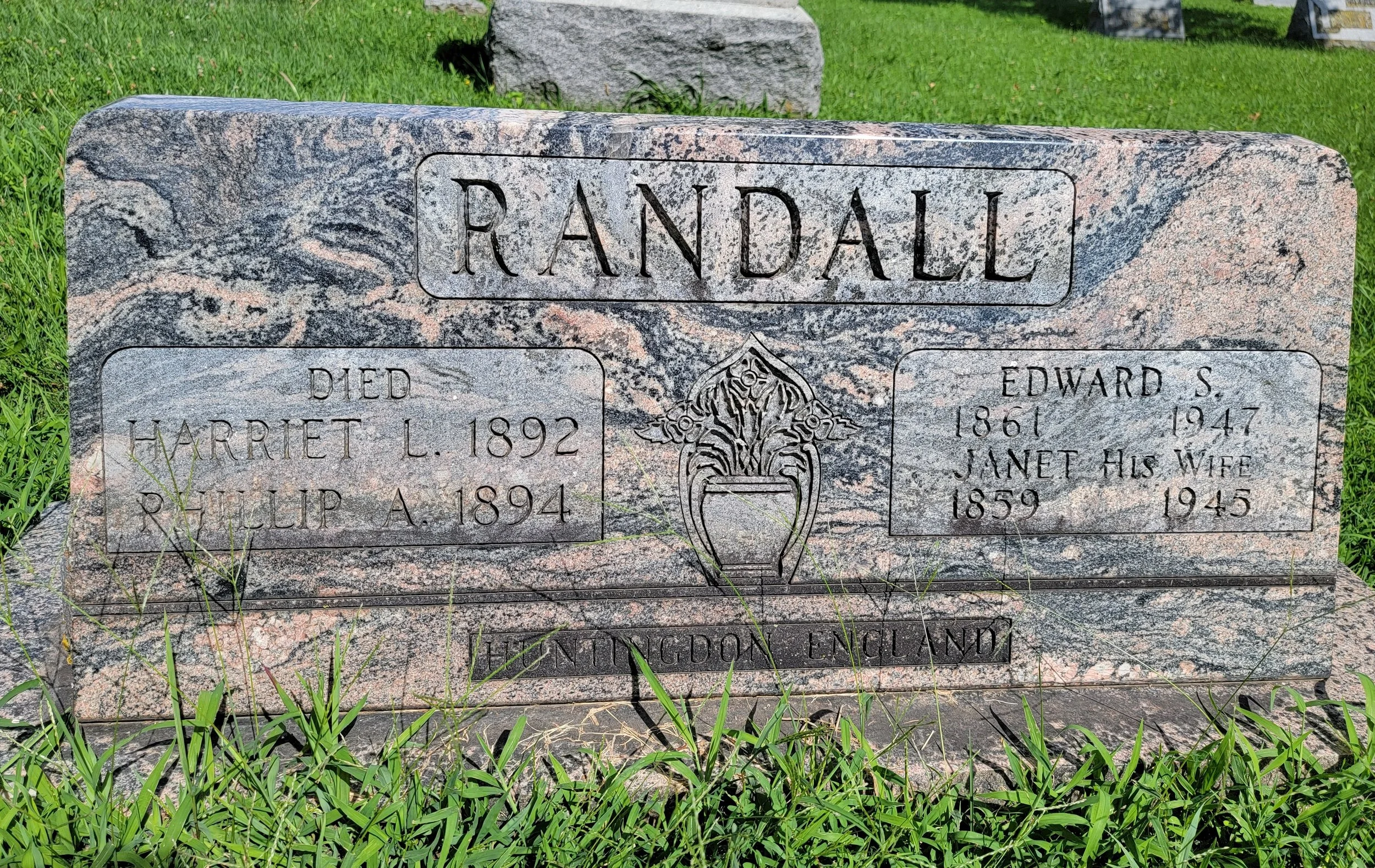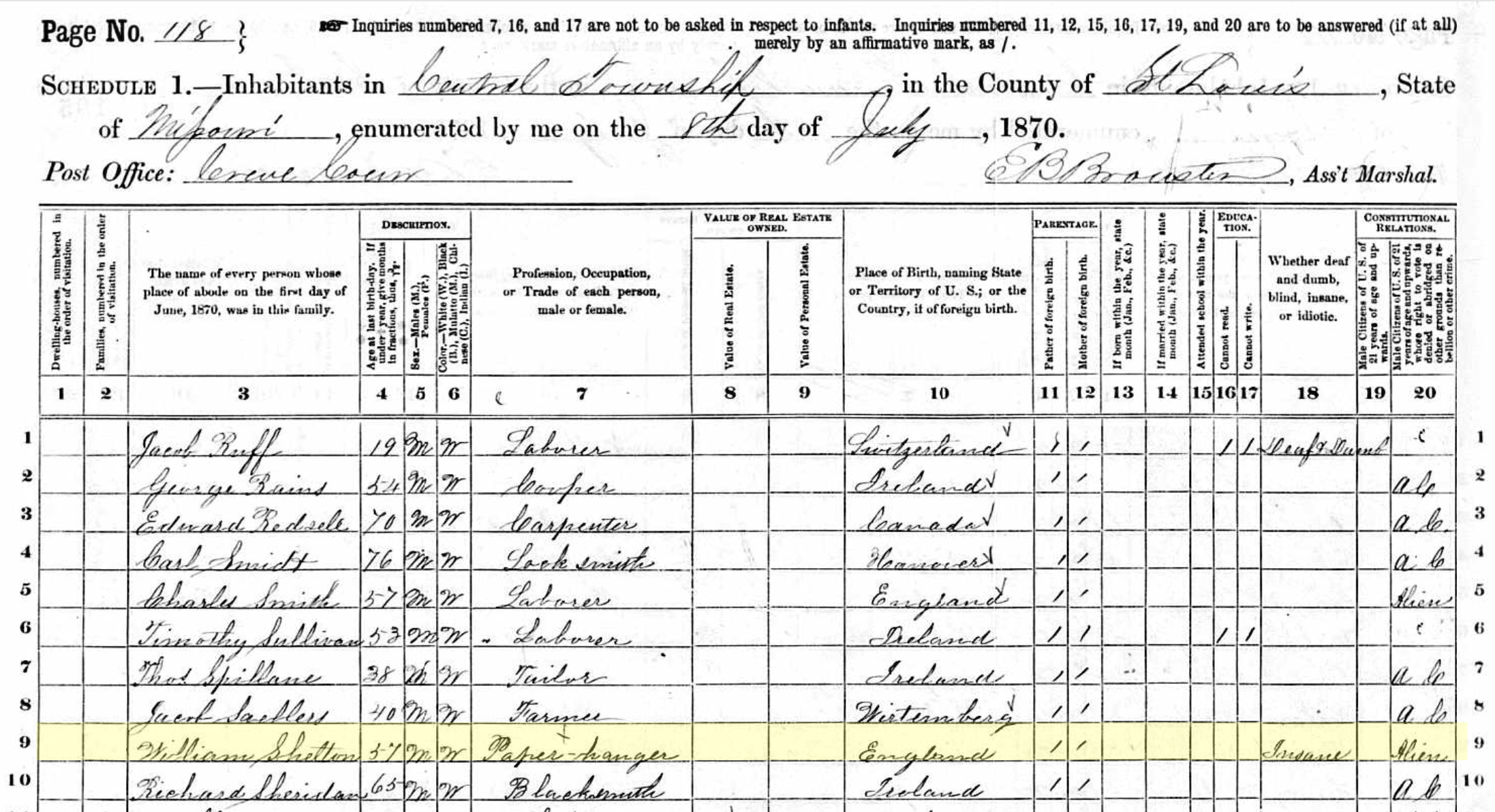This is the final installment of a series on the children of Charles Randall (1784-1849) and Mary Ann Allpress (1786-1830) of Huntingdon, England. Their five youngest were all boys: Edward, Frederick, Alfred, William, and Philip. Some of these boys struggled, probably due in part to the death of their mother when they were very young. Most of the boys ended up leaving Huntingdon.
Ed and Fred Randall
Edward (1821 - ?) and Frederick (1822-1885) were two English peas in a pod. They were close in age and ended up working together as turnkeys (jailers) at the Huntingdon County Gaol (jail). In the 1851 England Census, Edward was recorded as 3rd Turnkey at the gaol while his brother Frederick was recorded as 4th Turnkey.(1)
This was not an easy job. In 1849, just a few weeks after his father died, Edward was assaulted while on duty by a prisoner named Frederick Shaw. On April 30, 1849, the Gaol Keeper wrote that Frederick Shaw “used obscene and disgusting language toward Edward Randall, the third Turnkey” and later “violently kicked Randall upon the left leg.”(2) Two and a half years later, Edward got into a physical fight with the 4th Turnkey (his own brother) and was fired. This incident was mentioned in the local newspaper (3) and in local court records (4), but details are lacking. The 1852 Epiphany (January) session minutes simply state that the visiting justices resolved that Edward “be dismissed from this office … in consequence of an assault committed by him in the Gaol on his brother Frederick Randall and that Frederick Randall be appointed Third Turnkey in his place.” This likely would have been quite embarrassing for the family.
After his dismissal, Edward decided to leave Huntingdon and sail to Australia. In October 1852 he arrived at Port Philip, near Melbourne, a journey that took over 4 months. Frederick followed a few months later.(5) The brothers settled in Maldon, Victoria, which was founded in 1854 as a Gold Rush town at the Tarrangower gold fields. I have only a few records of the Randall brothers once they arrived in Australia, as follows:
In 1859 Edward was fined for being drunk in Maldon.(6) I have no record of him after this date.
In 1876 Frederick was a plaintiff in an assault case in Maldon. Fred complained that the defendant hit him one night in his garden. The defendant claimed that Fred was very drunk and had chased his children with dogs. The case was dismissed.(6, 7)
In May 1884 Frederick put his property up for sale.(8)
In September 1885 Frederick died in Maldon.(9) I can’t find a will or probate for him. I don’t think he had any heirs.
Sale of Mr. F. Randall's property at Nuggetty Reef, from The Tarrangower Times and Maldon Advertiser, 7 May, 1884
Alfred Randall
Although Alfred (1823-1882) was close in age to his brothers Edward and Frederick, he chose a different path and pursued a career as an “inland revenue” or excise officer, meaning that he worked in tax collection and tax compliance. He was married and had one son, named Alfred Edmund Randall. After living for a while in Wellington, Shropshire, Alfred returned to Huntingdon with his family, where he was well-regarded. His sudden death was covered in the local papers.(10)
Cambridge Weekly News, 9 Sep 1882
This article describes how Alfred’s body was found in a field in Huntingdon with his loyal greyhound dog by his dog. The body was then brought to a public house, in this case The Coach & Horses Inn, where the coroner held an inquest to determine the cause of death. It may sound strange to us today to hear that a dead body was brought into a pub, but that’s how it was often done in the past before towns had an official morgue or mortuary.
William Randall
This Randall brother sadly never made it to adulthood. William (1825-1843) took his own life at the age of 17, reportedly due to “melancholy” and unemployment.(11) The cause of death was recorded as “hanging in a fit of temporary insanity.”(12) At this point in time, his father Charles was still alive and all of his siblings (except his oldest brother Charles Jr) were still residing in Huntingdon. This would have been a very dark chapter for the family.
The Cambridge Chronicle and Journal, and Huntingdonshire Gazette, 15 July 1843
Philip Allpress Randall
The youngest brother, Philip (1827-1895), was just 3 years old when his mother died, so he probably had no memories of her. But he consistently used her maiden name (Allpress) as his middle name throughout his life.
Philip was a boot and shoe maker. He and his wife Eliza had 6 children who lived to adulthood.(13) In 1881 Philip sold his properties in the North End of Huntingdon and moved to Illinois with his son Edward Stephenson Randall (1860-1947), who became a farmer and raised a family in Nokomis.(14,15) Philip’s oldest daughter, Harriet Louisa Randall (1855-1892), arrived in the US the next year.(15) Philips’ other children remained in England.
Of all the places to go in America, why did the Randalls pick Nokomis? Presumably, farm land was plentiful here. But this decision must have been influenced by Philip’s older sister Mary Ann Shelton and her sons, who had settled in Nokomis by 1880. This shows that siblings Philip and Mary Ann were in contact even though they had not seen each other for many years - a heartwarming thought considering all the difficulties the family had been through.
The Randalls have a plot in Nokomis Cemetery with a very handsome headstone. Etched into the bottom of the stone are the words “Huntingdon, England” as a reminder to later generations of the family’s origins.
The Randall family plot in Nokomis Cemetery, Nokomis, IL, photographed in 2022
I paid a visit to the gravesite in 2022 on one of my regular Belleville to Chicago drives. If you are descended from Philip A Randall drop me a line! I have much more Randall information to share.
Sources
1851 England Census for Great Stukeley, Huntingdonshire.
Huntingdon County Gaol Keepers Journal (1847-1851). FamilySearch Image Group Number: 008179742, images 51-53 of 279.
Cambridge Weekly News, 10 Jan, 1852, pg 4.
Quarter Session Records of Huntingdon, Minute Books (1849-1863). FamilySearch Image Group Number: 008868600, image 165 of 224.
Victoria, Australia, Assisted and Unassisted Passenger Lists, 1839–1923.
Victoria, Australia, Petty Session Records, 1854-1922.
The Tarrangower Times and Maldon Advertiser, 27 May, 1876, pg 2.
The Tarrangower Times and Maldon Advertiser, 7 May, 1884, pg 3.
Australia Death Index, 1787-1985.
Cambridge Weekly News, 9 Sep 1882, pg 7.
The Cambridge Chronicle and Journal, and Huntingdonshire Gazette. 15 July, 1843, pg 3.
General Register Office. Death certificate for William Randall, 10 July, 1843
1871 England Census for St John’s Huntingdon, Huntingdonshire.
1920 U.S. Federal Census for Nokomis Township, Montgomery County, Illinois.
New York Passenger Lists, 1820-1957.






